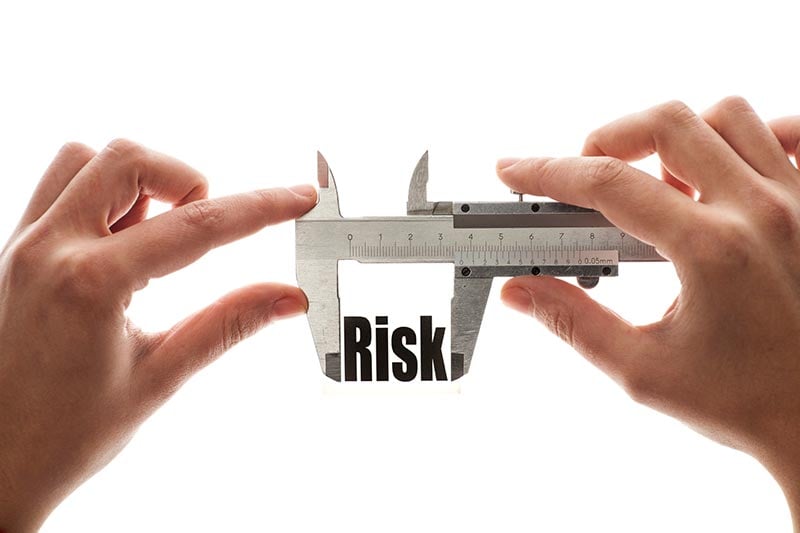
If there is one takeaway from our blogs, it’s that there is no such thing as risk-free investments. You measure your risk tolerance by understanding your financial goals and what type of return you are seeking. The general rule of thumb here is that the higher the risk, the higher the potential rate of return.
But how is portfolio risk measured?
There are many different measurement tools that can be used to analyze portfolio risk, based on factors ranging from historical predictors to volatility. While your financial planner should know these methods (and can calculate them for you), an overview of these measures can help you make educated decisions designed to enhance your portfolio.
Common Metrics
Mention the term “portfolio risk measures” to anyone who is familiar with investments, and their response will likely be “standard deviation,” “Sharpe ratio,” and “beta.”
Standard Deviation
Remember how we pointed out, above, that volatility is a risk measure? Well, standard deviation measures the volatility of investments. This metric is a statistical measure of dispersion, relative to the mean. In other words, it measures volatility according to return disparity, over a particular period of time--the higher the standard deviation, the riskier the investment.
Sharpe Ratio
When your financial planner uses the Sharpe ratio, they are measuring investment return against risk. The higher the ratio, the better the risk-adjusted performance.
Beta
Beta is another measure of volatility. But unlike the standard deviation, this metric compares the volatility of a particular instrument in comparison to the market as a whole. This is because the beta helps pinpoint the expected return from the capital asset pricing model.
Other Measures
Your financial planner will likely reach for additional measures to determine your portfolio’s risk. This is because they might want to understand absolute return (portfolio returns over a certain period of time) or relative return (how the portfolio performs against an index, benchmark, or market). This is where absolute and relative risk metrics come in.
Absolute Risk Metrics. The standard deviation, above, is an absolute metric. Others include value-at-risk (VAR) and shortfall risk.
- VAR examines the potential of extreme loss in the portfolio’s value over a certain period of time, and a given level of confidence.
- Shortfall risk focuses on the likelihood that an asset’s value will be less than what is required to meet portfolio objectives.
Relative Metrics
The Sharpe ratio and beta are examples of relative metrics. So are tracking error and information ratio.
- Tracking error focuses on the standard deviation of excess returns and compares them with a particular benchmark.
- The information ratio analyzes risk-adjusted returns of a portfolio’s asset against a particular benchmark or index.
Efficient Frontier
Finally, we have the efficient frontier, which is the basis of modern portfolio theory (MPT). Created by Nobel Laureate Harry Markowitz, the efficient frontier seeks to identify optimal portfolios; these portfolios pursue the highest expected return for a given level of risk (and are highly diversified, per MPT). The goal here is to create a portfolio that is efficient, when it comes to expected return as measured against perceived risk. Specifically:
A portfolio that exists on the efficient frontier strives to produce the highest expected return for a given level of risk.
A portfolio that falls below the efficient frontier is believed to provide a less-expected return for the same amount of perceived risk, or more exposure to perceived risk for the same expected return.
The More You Know
None of the above means you have to suddenly become a mathematician to understand your portfolio’s performance. But it can provide valuable insight when your financial planner starts talking about “Sharpe ratio” or “shortfall risk.” Understanding the tools that measure portfolio risk can help you, and your financial planner, make educated decisions that help you reach and maintain your investment goals.
Realized does not provide tax or legal advice. This material is not a substitute for seeking the advice of a qualified professional for your individual situation. This material is for general information and educational purposes only. Information is based on data gathered from what we believe are reliable sources. It is not guaranteed as to accuracy, does not purport to be complete and is not intended to be used as a primary basis for investment decisions. It should also not be construed as advice, meeting the particular investment needs of any investor. Risk tolerance is an investor’s general ability to withstand risk inherent in investing. There is no guarantee a recommended portfolio will accurately reflect your tolerance to risk.



